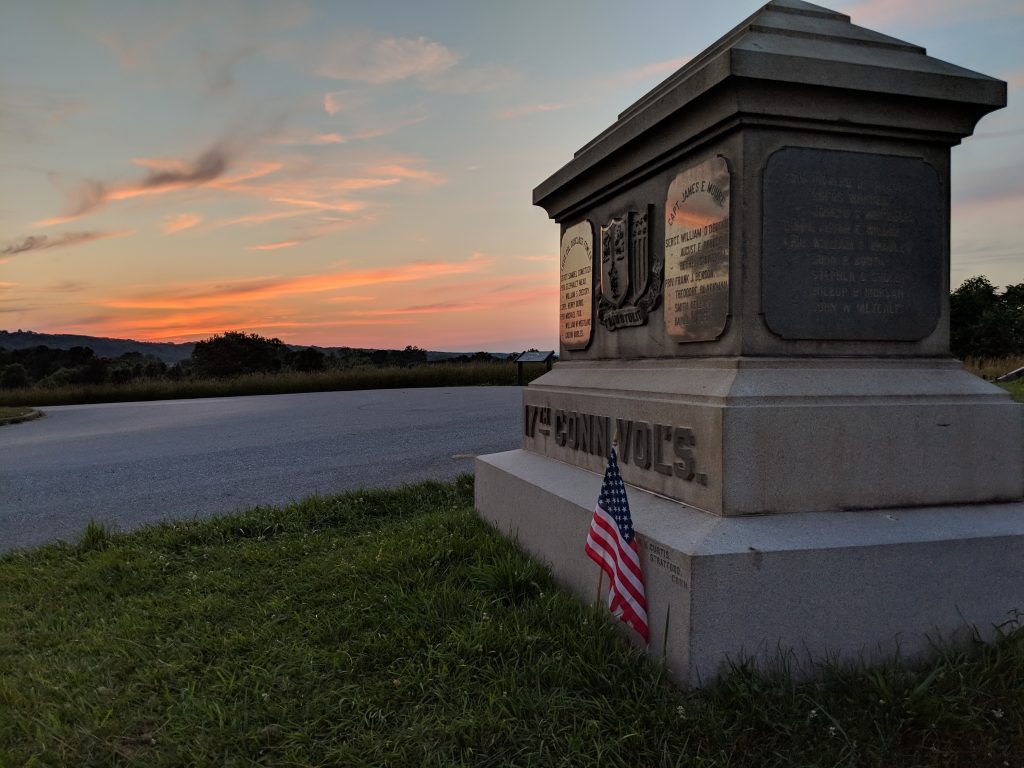One of the more interesting stories of the 17th Connecticut surrounds Elias Howe, Jr. – he of sewing machine fame, whose service in the regiment was told in this blog in July 2015 (Elias Howe, Jr. and the 17th).
In September and October 1867 several newspapers across the country printed a story telling of Howe’s enlistment in the regiment. A highlight of the story is the subsequent enrollment of his coachman, one Michael Cahill. According to these accounts, Cahill was so moved by his employer’s enlistment that he put his name down as well:
The next incident that occurred was one in which the comic and pathetic were blended. The coachman who had driven Mr. Howe’s carriage that evening, attracted by the continual cheers within the hall, had hired a boy to hold his horses, and had entered the building to witness the proceedings. He was a warm hearted Irishman, named Michael Cahill, past the age of military service as defined by law. Upon hearing his employer’s speech, he rushed forward, and clambering upon platform, cried out: “Put down my name, too! I can’t bear to have the old man go alone.”
So down went the name of Michael Cahill, coachman, next to that of Elias Howe. Laughter and cheers, mingled in about equal proportions, followed the announcement of “Mike’s” intentions. – Other names came in with great rapidity.
Later in the account, it is said that after completing his term of service in the 17th, “’Honest ‘Mike’…went to his old home and has advanced from driving Mr. Howe’s carriage to driving his own horse and cart, which he is still doing.”
This is such an interesting story that it begs the question – who was “Honest” Mike Cahill?
A search of the original muster rolls of the 17th finds only one Michael Cahill, age 45, and occupation listed as farmer, who enlisted in Company K on August 9, 1862. The service with the regiment for this Michael Cahill ended when he was discharged due to disability a year later in August 1863.
A search of the US Census Records finds several Michael Cahill’s. While no Michael Cahill can be found residing in Fairfield or Bridgeport in the 1860 census, there is only one who lived in the Bridgeport area in later census years (namely the 1870 and 1880 census). Let’s assume for the purposes of this exercise that “Honest Mike,” working as he did for Elias Howe, resided in Bridgeport, with that city also being a good guess since Company K was made up primarily from residents of Bridgeport and Fairfield.
A check of the 1870 census finds a Michael Cahill, born about 1822, living in Bridgeport and listing his occupation as “drives team.” In 1880 he is still in Bridgeport and is now occupied as a “cartman,” which among other things is someone who hauls goods. In 1884 this same Michael Cahill applied for an Invalid Pension, and one of the contributors to the 17th CVI monument on Barlow’s Knoll was Michael Cahill of Bridgeport. Those census records show his wife’s name as Bridget, and both Michael and Bridget are buried in St. Augustine Cemetery in Bridgeport, CT (this cemetery has an interesting story as well, click here to read about the restoration of this forgotten and neglected cemetery). His gravestone (put up by his grandchildren according to the inscription on the stone) offers no clue to his Civil War service.
Is this, then, the “Honest” Mike of the story? Or is this just a good story put forth in the style of the 19th century press to enliven the story of Elias Howe, Jr.? A look at Cahill’s pension file would offer some clues here. Perhaps someone knows more about the Michael Cahill/Elias Howe/17th CVI connection but for now the story of old “Honest Mike” Cahill remains something of a mystery.


